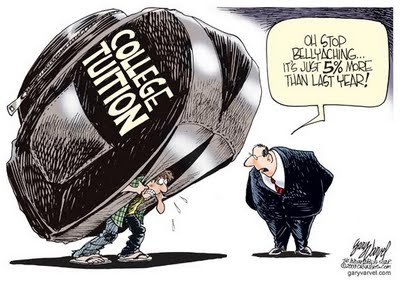 Rising tuition costs are a problem at institutions of higher learning around the country. When it is more expensive to go to college, fewer people can afford it. Various strategies have been tried to fix this problem, but the latest hits close to home for me. This week, South Carolina governor Mark Sanford proposed strict new spending rules for public colleges. From the Charleston Post and Courier article:
Rising tuition costs are a problem at institutions of higher learning around the country. When it is more expensive to go to college, fewer people can afford it. Various strategies have been tried to fix this problem, but the latest hits close to home for me. This week, South Carolina governor Mark Sanford proposed strict new spending rules for public colleges. From the Charleston Post and Courier article:
“The state’s Budget and Control Board could decide this week whether to place a moratorium on new building projects on public college and university campuses as a way to reduce the cost of tuition.”
Statewide, school administrators have greeted this announcement with strong resistance. Fundamentally, it all comes down to different philosophies of government. Conservatives like Mark Sanford support lower taxes and lower spending, while liberals favor a “tax and spend” strategy. Which is more appropriate for state-funded colleges?

More information can shed some light on this dilemma. The Post and Courier article points out some interesting facts that Governor Sanford, a lifelong champion of “small government” left out of his speech:
“State funding for higher education is low in South Carolina. The level at which it funds its universities falls second from the bottom among the 16 Southern states. Only West Virginia contributes less to its colleges, according the Southern Regional Education Board, a group that represents those states. And tuition at South Carolina’s public four-year schools is the highest in the South.”
In other words, tuition at public schools in South Carolina is so expensive partially because they receive less money from the state government than other public colleges. This means that “extravagant spending” on new facilities isn’t the problem, and reducing this spending won’t necessarily help reduce tuition. Also, these new facilities are actually kind of important:
“Institutions also compete with one another for applicants and prestige, and one way they do that is by improving facilities and amenities for students.”
College of Charleston student body President Isaiah Nelson elaborated in a post on the grad school’s blog:
“As many of you know, the College’s Student Body doubled from roughly 5,000 to roughly 10,000 students from 1990-2001. In 2003, the College completed a facilities master plan that found the College was well short of the square footage necessary for our capped Student Body of 10,000. The College undertook a massive campus-wide project to update our campus to provide for our students the buildings that were necessary for the size of our student body. The completion of buildings such as the Carolina First Arena, the New Science Center, the renovation of the Stern Center, and the Cato Center for the Arts were necessary and welcome additions to the College that updated our campus to adequately serve the student body. With this proposal, many of our historic buildings that may be in need of necessary repairs in the near future would not be able to be renovated. Projects such as the renovation of the Hungry Cougar or offices on campus, which are vital to improving our university, could be in danger.
While I’m not sure that I’d use the new basketball arena or the snack bar as an example of how important new buildings are, I largely agree with Isaiah’s point. New buildings, as well as renovations to old buildings, are extremely important to a college, particularly one that is growing as quickly as the College of Charleston.
While this is the first time I’ve heard of this exact strategy being proposed by a government official, the theory behind it is nothing new- Republicans often oppose “throwing money at the problem” of our country’s under-performing schools. I’ve never understood this argument- while it is undeniable that some major structural reforms are needed, things like textbooks and desks and good teachers cost money. When schools don’t have these things, they need to buy them, which requires “throwing some money” at them.
Also, it’s worth noting that Governor Sanford will only be our Governor for a few more months, so perhaps he shouldn’t be proposing major reforms in the eleventh hour of his term (even if they actually are a good idea, which this is not).
If you are interested in sharing your opinion on this issue, please fill out this online form. If you’re really outraged, you can also support Vincent Sheheen, a Democrat running to replace Mark Sanford for Governor, by clicking here.

~WhySharksMatter
Honestly, I don’t really have a handle on the nuances of this problem. However, from my perspective I can see the need for colleges to curtail certain vanity building projects. For instance, and my university, a load of money has been spent prettying up the parking lots and walking paths. Also, they are building a massive, lavish new preforming arts building which negated hundreds of parking spots from what is primarily a commuter school. Meanwhile, professors are forced to take mandatory furlow days (on which they still need to come in and manage their labs).
This sort of construction seems primarily cosmetic and not necessary towards the education mission of universities.
Schools will charge as much as physically possible for tuition, and take as much as the government will dare give them. They will build stuff with that money (either actual buildings or to further inflate the already bulbous administrations) weather it is necessary or not.
Is your school public or private, Michael?
Sure, some schools make some unwise financial decisions when it comes to construction (a misting system outside the student union at Duke cost tens of thousands of dollars, for example). That doesn’t mean that the government should ban any kind of new construction or renovation.
It is a public school.
I agree that the government should not ban all new construction. I think they should better make sure that the right things are getting built at the right time.
I was at CofC when they were doing all the planning and they seriously need the extra space as the existing facilities are overcrowded and some are downright dilapidated. This is some draconian answer that people believe will solve all the ills and make college affordable for everyone. Sadly it will not change much and lead to further neglect and outmoding of infrastructure at these state colleges.
“make sure that the right things are getting built at the right time.”
Sure, we’re in agreement there.